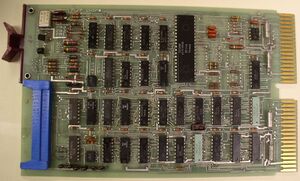Difference between revisions of "DLV11 asynchronous serial line interface"
m (New cat scheme) |
m (→External links: +manuals) |
||
| Line 22: | Line 22: | ||
==External links== | ==External links== | ||
| − | + | ||
| − | * [http://www.bitsavers.org/pdf/dec/qbus/Digital_Microcomputer_Interfaces_Handbook_1980.pdf microcomputer interfaces handbook] - the DLV11 is covered on pp. 173-187 | + | * [http://www.bitsavers.org/pdf/dec/pdp11/1103/EK-LSI11-TM-002.pdf LSI-11, PDP-11/03 user's manual] (EK-LSI11-TM-002) - the DLV11 is covered in Section 6.2 (pp. 91-95 of the PDF) |
| + | * [http://www.bitsavers.org/pdf/dec/qbus/Digital_Microcomputer_Interfaces_Handbook_1980.pdf microcomputer interfaces handbook] - the DLV11 is covered on pp. 173-187 of the PDF | ||
| + | * [http://www.bitsavers.org/pdf/dec/qbus/Digital_Microcomputer_Products_Handbook_1985.pdf Microcomputer Products Handbook] - the DLV11 is covered in Chapter 21 (pp. 285-291 of the PDF) | ||
* [http://www.bitsavers.org/pdf/dec/qbus/MP00055_DLV11_Jun76.pdf DLV11 Field Maintenance Print Set] (MP00055) | * [http://www.bitsavers.org/pdf/dec/qbus/MP00055_DLV11_Jun76.pdf DLV11 Field Maintenance Print Set] (MP00055) | ||
[[Category: QBUS Asynchronous Serial Interfaces]] | [[Category: QBUS Asynchronous Serial Interfaces]] | ||
Revision as of 13:22, 7 July 2023
The DLV11 asynchronous serial line interface card (M7940) was a QBUS peripheral for the PDP-11 series of computers which provided an asynchronous serial line on a single dual-width card.
It provided both EIA RS-232, and active or passive 20 mA connectivity, at speeds of 110 to 9600 baud; it had vestigial modem control. Line connection was via 40-pin Berg connector headers on the top edge of the card, using the standard DEC asynchronous serial line pinout.
Configuration was via wire-wrap jumpers.
Programing interface
Like the ancestral KL11, the DLV11 has 2 device registers for the receive side (one Control and Status Register - CSR - and one data buffer register), and similarly, two for the transmit side. Each line has two interrupt vectors - again, one receive, and one transmit.
For the PDP-11 main console (which is always a KL11/DL11 compatible device), the standard is that 0777560 is the base address (so the receiver registers are 0777560-2, and the transmitter are 0777564-6), and 060 is the base vector. It can be set to halt the CPU when a 'break' is seen.
The first line after the console is always assigned the address 0776500, and vector 0300. Additional lines are assigned addresses and vectors immediately following, for DL11's #1-#16 (i.e. 0776500-676 and 0300-0476).
See also
- DLV11-E asynchronous serial line interface
- DLV11-F asynchronous serial line interface
- DLV11-J asynchronous serial line interface
External links
- LSI-11, PDP-11/03 user's manual (EK-LSI11-TM-002) - the DLV11 is covered in Section 6.2 (pp. 91-95 of the PDF)
- microcomputer interfaces handbook - the DLV11 is covered on pp. 173-187 of the PDF
- Microcomputer Products Handbook - the DLV11 is covered in Chapter 21 (pp. 285-291 of the PDF)
- DLV11 Field Maintenance Print Set (MP00055)
